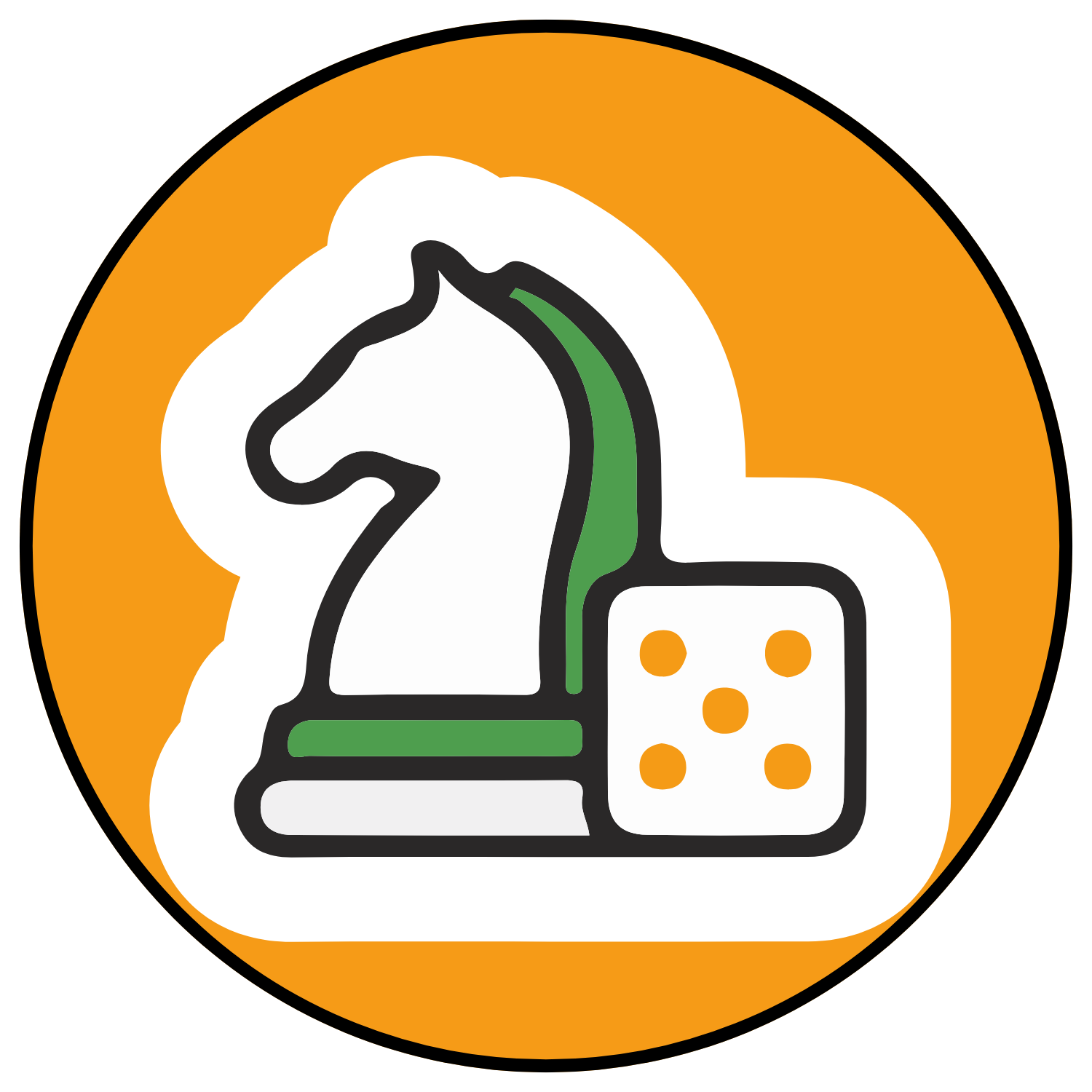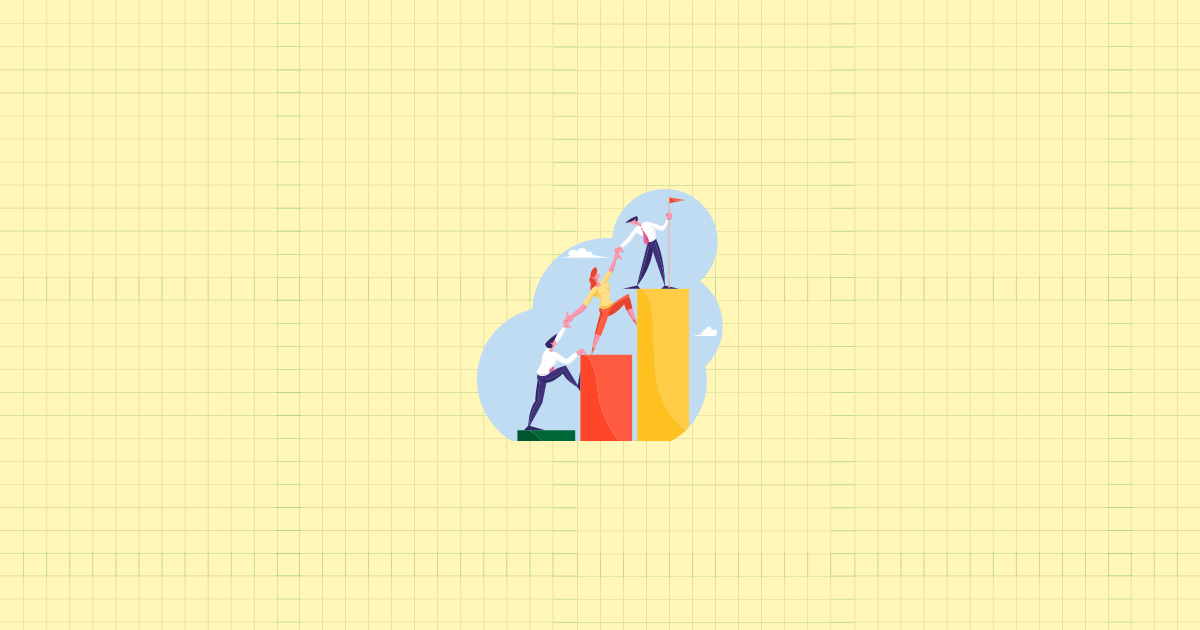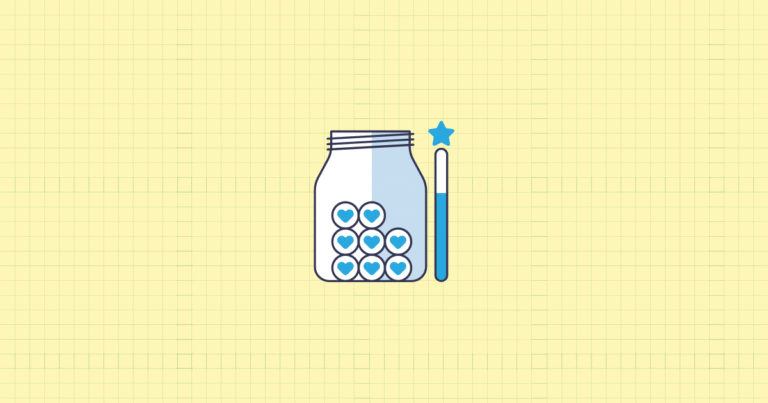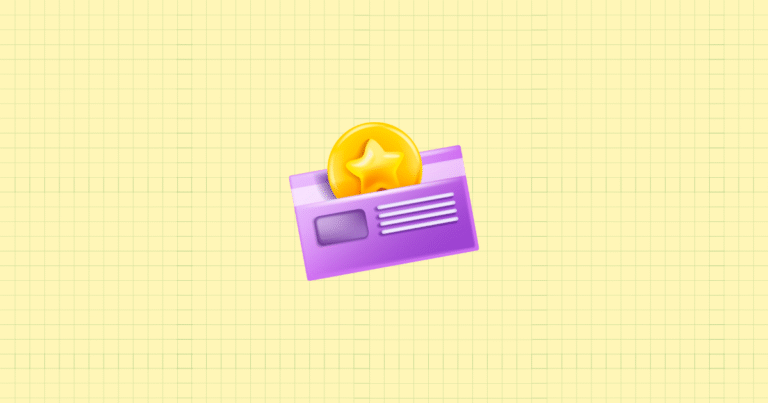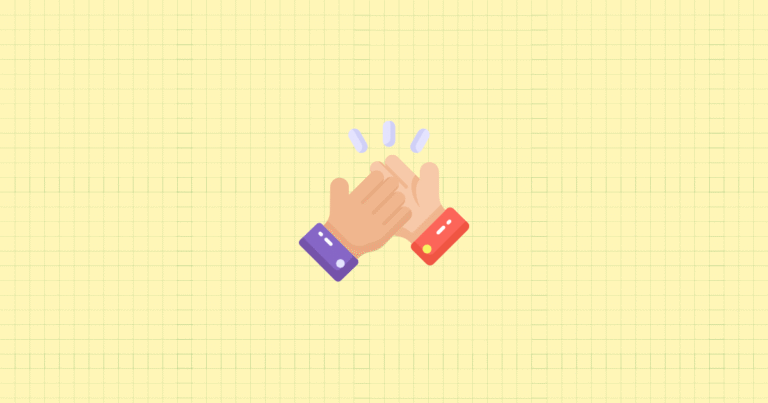Introduction: The Psychology Behind Gamified Loyalty Programs
Remember the last time you couldn’t put down a mobile game? That same addictive quality can transform your Shopify store’s loyalty program from forgettable to irresistible. Traditional point-based loyalty programs are dying a slow death—customers collect points, maybe redeem them, but rarely feel genuine excitement. The problem isn’t the concept of loyalty; it’s the execution.
Gamification changes everything. By tapping into fundamental human psychology, gamified loyalty programs create the same dopamine hits that keep gamers playing for “just five more minutes.” And for Shopify store owners facing increasing customer acquisition costs, that engagement translates directly to your bottom line.
In this guide, you’ll discover how to transform passive points collectors into enthusiastic brand advocates through strategic gamification. I’ll show you exactly which elements create that “just one more” feeling, how to implement them technically on Shopify, and the measurable impact they’ll have on your customer lifetime value.
The Evolution of Loyalty Programs in E-commerce
Traditional loyalty programs follow a predictable pattern: spend money, earn points, eventually redeem for a discount. Simple, but hardly inspiring. Many customers forget they’re even enrolled, points expire unused, and the program becomes another forgotten marketing initiative.
Why do conventional programs fail? They rely almost exclusively on extrinsic motivation—the discount or freebie at the end. But psychology shows us that intrinsic motivation—the enjoyment of the experience itself—creates far more powerful engagement loops.
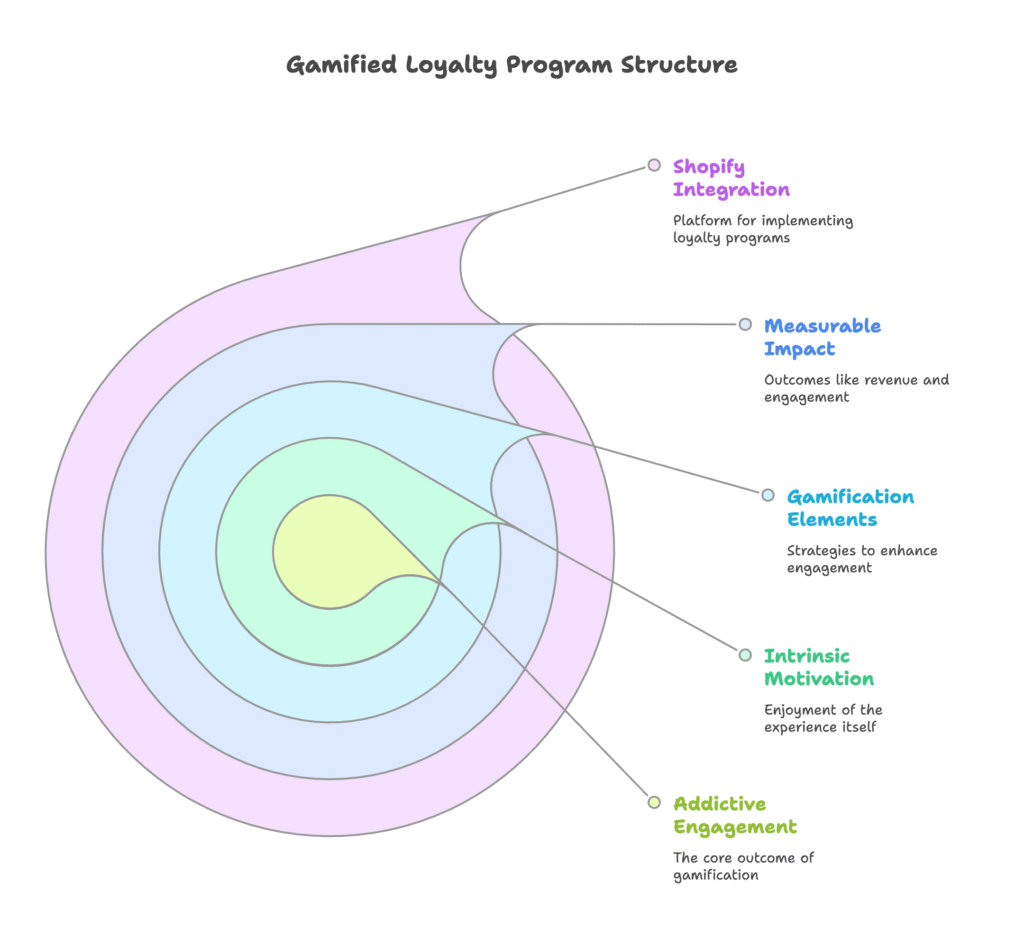
Think about the difference between forcing yourself to jog (extrinsic: to lose weight) versus playing an exhilarating game of basketball (intrinsic: it’s fun). Both burn calories, but one feels like work while the other feels like play. That’s the gamification difference.
Why Gamification Works Specifically for Shopify Stores
Shopify merchants face unique challenges in today’s crowded marketplace. Ad costs continue to climb. Customer attention spans shrink by the season. And standard promotions barely register in consumers’ promotion-saturated inboxes.
Consider these sobering statistics: the average customer needs five purchases before considering themselves loyal, yet most never make it past a second purchase. Meanwhile, increasing customer retention by just 5% can boost profits by 25-95%, according to research by Bain & Company.
Gamified loyalty turns these challenges into opportunities. When implemented correctly, these programs deliver remarkable results:
- 15-25% increase in revenue from existing customers
- 40% higher engagement with brand communications
- 3.5x more products browsed per session
- Significantly richer customer behavior data
But not all gamification elements are created equal. Let’s explore the building blocks that make loyalty truly addictive.
Core Gamification Elements for Shopify Loyalty Programs
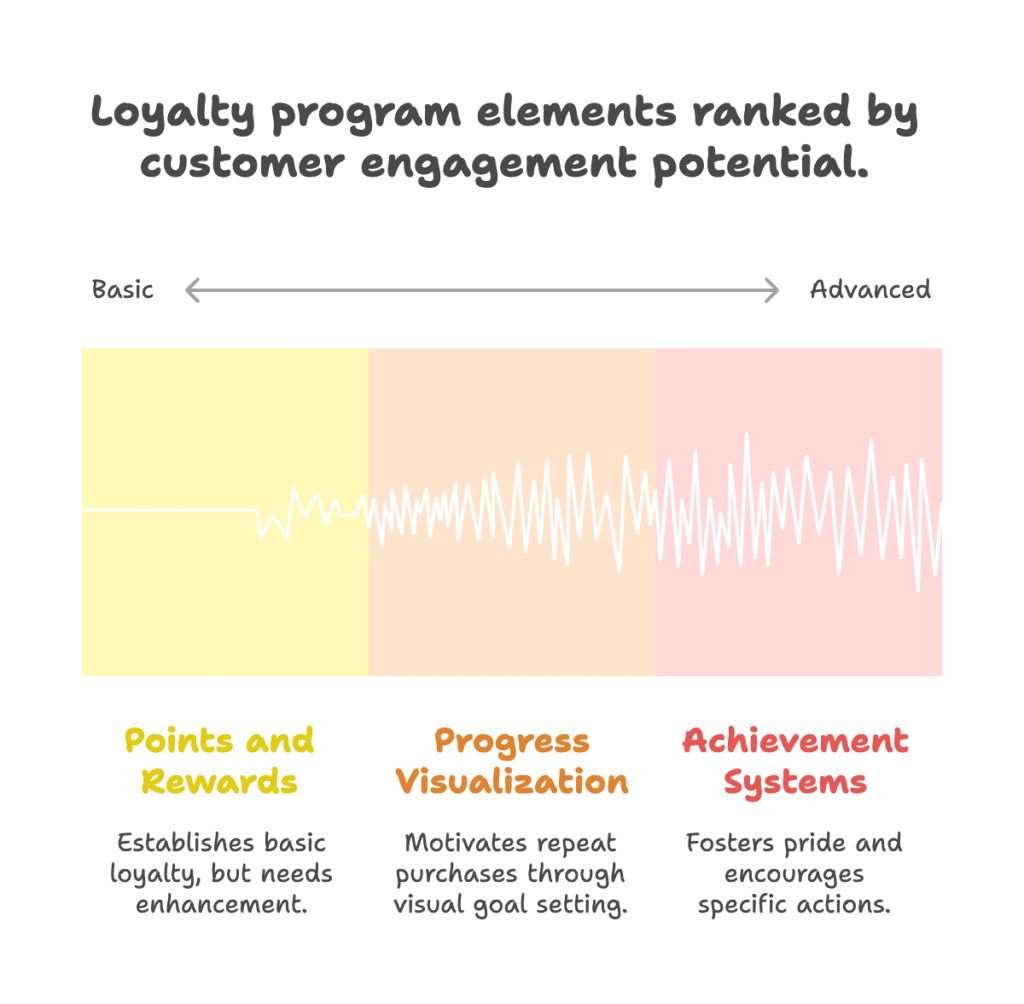
Points and Rewards Systems
Points systems form the foundation of most loyalty programs, but standard “spend $1, earn 1 point” structures barely move the engagement needle. The magic happens when you expand beyond pure transaction-based rewards.
The most engaging Shopify loyalty programs offer multiple earning paths. Reward social media follows, product reviews, friend referrals, birthday celebrations, and even quiz completions. This diversity creates more touch points and reasons to interact with your brand between purchases.
But points mean nothing without proper valuation. Too generous, and you’ll hurt margins; too stingy, and customers won’t bother. My testing across dozens of Shopify stores suggests an ideal redemption value between 5-10% of purchase price, with new customers offered higher initial values to demonstrate immediate program value.
Strategic reward mechanisms extend beyond simple discounts. Consider these high-engagement alternatives:
- Early access to new products (exclusivity without margin impact)
- Limited-edition items available only to members (creates collectibility)
- Free shipping unlocks at different membership levels (reduces cart abandonment)
- Partner rewards and experiences (extends perceived value beyond your products)
One Shopify beauty brand I worked with replaced their flat 10% reward discount with tiered rewards—samples at lower levels, free shipping in the middle, and early access to limited editions at the top. Redemption rates increased 34%, while program costs decreased 22%.
Progress Visualization and Achievement Systems
People love seeing progress. It’s why fitness apps display streaks, steps, and stats so prominently. Your loyalty program should create the same visual satisfaction.
Progress bars are the simplest yet most effective implementation. Showing customers they’re “$15 away from unlocking free shipping” or “2 purchases from reaching Silver status” creates immediate goals that drive action. The endowed progress effect—where people accelerate effort as they near completion—makes these visualizations particularly powerful for encouraging that “one more purchase” behavior.
Achievement and badge systems take this motivation further by recognizing specific behaviors. Strategic badge designs might include:
- “First Purchase” badges to celebrate new customers
- “Collection Complete” for purchasing across product categories
- “Trend Setter” for early purchasers of new products
- “Brand Ambassador” for social shares and referrals
The brilliance of badges? They cost nothing to award but create genuine pride and accomplishment. A home goods Shopify store I consulted for implemented “room completion” badges for purchasing complementary items, increasing cross-category shopping by 28%.
The key technical consideration for Shopify stores: ensure these visual elements appear prominently in your store interface and email communications, not buried in a separate rewards portal customers rarely visit.
Interactive Game Mechanics for Shopify Loyalty
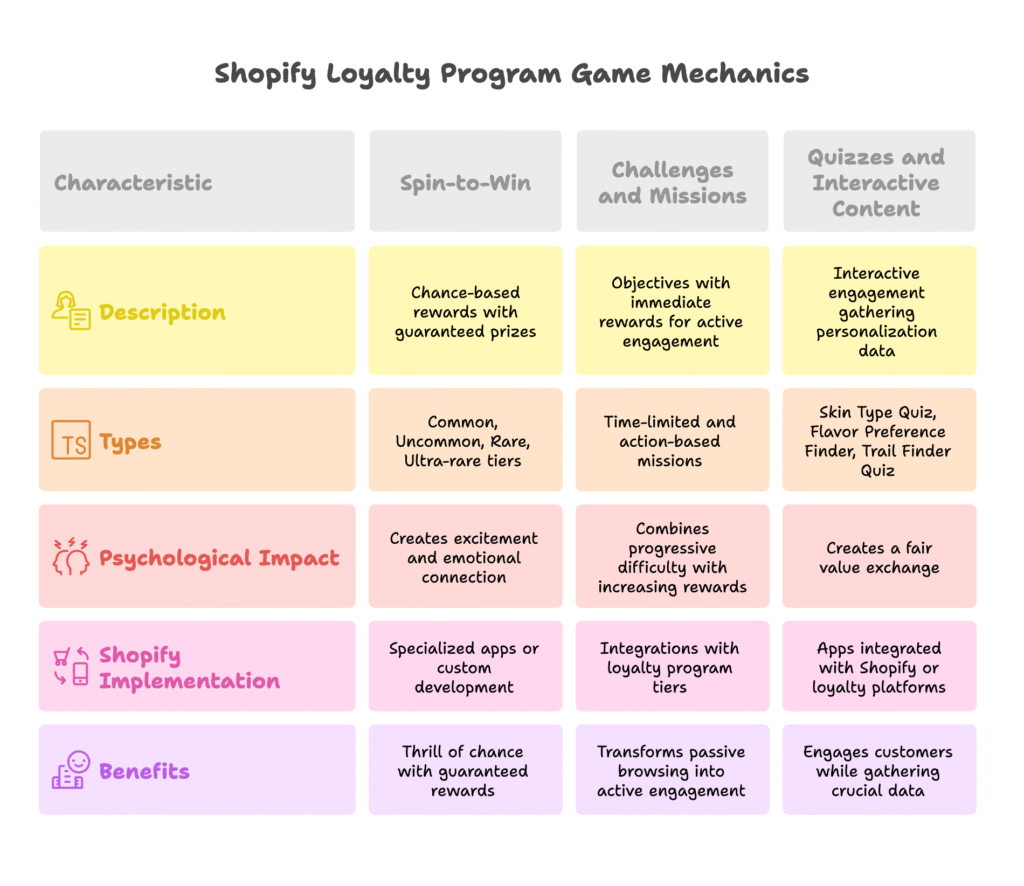
Spin-to-Win and Chance-Based Rewards
Las Vegas wasn’t built on predictability. The uncertainty of what you might win creates a powerful anticipation response in the brain—a neurological cocktail of dopamine that standard “earn 100 points, get $5 off” programs can’t match.
Spin-to-win wheels have become increasingly popular on Shopify stores, and for good reason. They combine the thrill of chance with guaranteed rewards. The key is careful prize distribution:
- Common tier: 5-10% discounts, free shipping (60-70% of wheel)
- Uncommon tier: $10-15 discounts, free gift with purchase (20-25% of wheel)
- Rare tier: Larger discounts, free products (5-10% of wheel)
- Ultra-rare tier: Major prizes, significant discounts (1-2% of wheel)
The psychological impact is remarkable. A customer who “wins” a 10% discount through a spin feels far more excited than if you simply offered everyone 10% off. The victory, not just the discount, creates the emotional connection.
Implementation on Shopify requires either a specialized app or custom development. Options like Spin-a-Sale, VYPER, or Privy offer turnkey solutions that integrate with your existing theme. More advanced Shopify Plus stores might consider custom implementations that tie the prize wheel directly to their loyalty program tiers, offering better prizes to higher-tier members.
Challenges and Missions
Challenges transform passive browsing into active engagement by giving customers clear objectives and immediate rewards. The most effective challenges fall into two categories: time-limited and action-based.
Time-limited challenges create urgency: “Complete a purchase in the next 24 hours to earn double points” or “This weekend only: Earn a limited-edition badge for trying our new collection.” These work particularly well during slower sales periods or for new product launches.
Action-based missions encourage specific behaviors: “Share your purchase on Instagram to unlock a special reward” or “Leave three product reviews to earn exclusive access to our pre-sale event.” These challenges should align with behaviors that benefit your business while feeling achievable to customers.
The psychological magic happens when you combine progressive difficulty with increasing rewards. Start new loyalty members with simple challenges, then gradually introduce more complex multi-step missions as they engage more deeply with your brand.
A fashion Shopify store I worked with implemented a “Style Challenge” system that rewarded customers for purchasing across complementary categories. The result? A 41% increase in average order value from program participants compared to non-participants.
Quizzes and Interactive Content
Quizzes serve dual purposes in gamified loyalty programs: they engage customers while gathering crucial personalization data. A beauty store’s “Skin Type Quiz” or a coffee shop’s “Flavor Preference Finder” creates an interactive experience while helping you segment your audience for targeted marketing.
The completion of these quizzes should unlock immediate rewards: personalized product recommendations, custom discount codes, or loyalty points. This creates a fair value exchange—customers share information and receive personalized value in return.
For Shopify implementation, apps like Octane AI, Typeform integrated with Shopify, or dedicated loyalty platforms like Smile.io or LoyaltyLion offer quiz functionalities that connect directly to your loyalty program.
One outdoor equipment Shopify store created a “Trail Finder Quiz” that matched customers with appropriate gear for their hiking level. Quiz completers spent 67% more than non-quiz customers, and the store gained invaluable segmentation data that improved email marketing performance by 43%.
Loyalty Program Structure and Tiers
Designing Effective Tier Systems
Loyalty tiers add aspirational goals to your program. Done right, they transform transaction-focused customers into status-seeking brand advocates. But tier structure requires careful balancing.
The most effective Shopify loyalty programs typically use 3-4 tiers with these characteristics:
- Entry tier: Easily attainable, offering immediate but modest benefits
- Middle tier(s): Requiring reasonable effort but delivering substantially better rewards
- Top tier: Aspirational status with genuinely exclusive benefits
The thresholds between tiers create the motivational tension. Set them too far apart, and customers lose motivation; too close together, and tier status feels meaningless. For most Shopify stores, I recommend these general guidelines:
- Entry tier: Immediate upon program enrollment
- Middle tier: Achievable within 2-3 typical purchases
- Higher tiers: Requiring consistent patronage over 3-6 months
Equally important is how you name and visualize these tiers. Generic “Bronze/Silver/Gold” naming feels corporate and uninspiring. Instead, align tier names with your brand identity—a coffee shop might use “Brew Beginner,” “Caffeine Enthusiast,” and “Coffee Connoisseur,” while a cosmetics brand could use “Glow Getter,” “Beauty Insider,” and “Glamour Guru.”
Tier-Based Benefits Strategy
The key question: What benefits truly motivate loyalty at each tier?
Entry-level benefits should demonstrate immediate value without significant cost—birthday rewards, modest points accelerators (1.2× points), and special occasion perks. The goal is showing program value, not delivering maximum rewards.
Middle-tier benefits should noticeably improve the shopping experience—free shipping, early access to sales (24 hours before public), higher points earning rates (1.5× points), and priority customer service.
Top-tier benefits must deliver genuine exclusivity—concierge services, significant points multipliers (2× or higher), exclusive products, personalized offers, and VIP events. The psychological appeal of “membership in an exclusive group” drives spending far beyond the actual monetary value of these perks.
One luxury accessory Shopify store implemented a top tier that included personalized product recommendations from their lead designer. This cost them minimal time but created such perceived value that top-tier customers increased annual spending by 240%.
Remember: customers will spend considerably more to maintain a status than to achieve it initially—the psychological principle of loss aversion. Once customers reach higher tiers, clear communication about what they’d lose by dropping tiers becomes a powerful retention tool.
Technical Implementation on Shopify
Loyalty App Selection Criteria
Shopify’s app ecosystem offers numerous loyalty solutions, but capabilities vary dramatically. Evaluate potential apps against these critical criteria:
- Gamification features: Does it offer the specific elements you need (points, tiers, challenges, etc.)?
- Customization flexibility: Can you tailor the visual elements to match your brand identity?
- Mobile responsiveness: How does the loyalty interface appear on smartphones (where 70%+ of browsing occurs)?
- Integration depth: Does it connect with your email platform, customer support system, and other key apps?
- Data accessibility: Can you export program data for analysis or segmentation?
Popular options include Smile.io, LoyaltyLion, Yotpo, and Stamped, each with their own strengths. Smile.io excels in user-friendly interfaces, LoyaltyLion offers extensive customization, Yotpo provides strong integration with review systems, and Stamped combines reviews with loyalty functionality.
For more advanced Shopify Plus stores, Loyalty Cloud offers enterprise-level capabilities with API access for custom implementations. Your selection should align with your technical capabilities, budget, and specific gamification needs.
Setup and Configuration Process
Once you’ve selected your loyalty platform, proper implementation is crucial. Follow this sequence for optimal results:
- Install the app and complete basic setup (branding, colors, program name)
- Configure point values and earning activities (purchases, social follows, reviews, etc.)
- Create and balance your tier structure (entry requirements and benefits)
- Design your reward exchange options (discounts, free products, exclusive perks)
- Set up any challenges or missions with appropriate rewards
- Implement and test front-end widgets (account dashboard, pop-ups, etc.)
- Create enrollment incentives (bonus points for signing up)
- Develop launch communications (email, social, on-site announcements)
Widget placement significantly impacts program visibility and enrollment. The most effective locations include:
- Floating tab or button on all pages (subtle but omnipresent)
- Account dashboard integration (detailed program status)
- Cart page (showing points potential for current purchase)
- Post-purchase page (celebrating points earned)
- Product pages (displaying member-exclusive pricing)
Mobile optimization deserves special attention. Ensure all program elements—point displays, progress bars, tier indicators—remain visible and functional on smaller screens without hampering the shopping experience.
Optimizing Engagement with Advanced Strategies
Customer Segmentation and Personalization
Generic loyalty communications generate generic results. The most effective programs leverage customer data for targeted engagement strategies based on specific behaviors and preferences.
Begin with these foundational segments:
- New enrollees (focus: program education and first reward acceleration)
- Point accumulators (focus: redemption opportunities and tier progression)
- Frequent redeemers (focus: higher-value rewards and exclusive experiences)
- At-risk members (focus: re-engagement campaigns with immediate value)
- VIP tier customers (focus: recognition, exclusivity, and personalized attention)
Personalization extends beyond simply using a customer’s name. True personalization means tailoring the entire loyalty experience to individual behavior patterns. Examples include:
- Custom challenges based on browsing history (“We noticed you’ve been looking at our winter collection—complete a purchase to earn double points”)
- Category-specific rewards for frequent purchasers (“As our top skincare customer, unlock this exclusive serum”)
- Personalized point accelerators in favorite product categories
- Milestone celebrations specific to customer history (“Congratulations on your 10th purchase of our signature product!”)
A home décor Shopify store implemented room-specific rewards based on purchase history, offering living room accessories to customers who previously purchased sofas. This targeted approach increased redemption rates by 78% compared to generic rewards.
Communication and Promotion Strategies
Even the most brilliantly designed loyalty program fails without effective communication. Develop a multi-channel strategy to maintain program awareness and engagement:
- Welcome sequence: Detailed program introduction, initial point bonus, first challenge
- Status updates: Monthly point balances, progress toward next tier, available rewards
- Opportunity alerts: Limited-time challenges, point multiplier events, expiring points
- Behavior triggers: Points earned notifications, tier achievements, reward eligibility
- Re-engagement campaigns: Point boosts for returning after inactivity
The timing of these communications significantly impacts their effectiveness. Immediate post-action notifications (e.g., “You just earned 500 points!”) create stronger behavioral reinforcement than delayed summaries.
For Shopify stores with physical locations, bridge online and offline experiences by training staff to reference the customer’s loyalty status during interactions. “I see you’re just 200 points away from our VIP tier” creates continuity between digital and physical shopping experiences.
Measuring Success and Continuous Improvement
Key Performance Indicators for Gamified Loyalty
Measuring program success requires tracking both engagement metrics and business impact indicators. The most revealing metrics include:
- Program enrollment rate (% of customers who join)
- Active engagement rate (% of members who earn/redeem within 90 days)
- Points economy balance (points issued vs. redeemed)
- Tier distribution (% of members in each tier)
- Challenge completion rates (% of started challenges finished)
- Reward redemption frequency (average time between redemptions)
- Repeat purchase rate differences (members vs. non-members)
- Average order value impact (members vs. non-members)
- Customer lifetime value change (pre-program vs. post-enrollment)
Beyond these quantitative measures, qualitative feedback provides crucial context. Regular surveys, focus groups with high-tier members, and analysis of customer service interactions help identify both friction points and unexpected delight factors within your program.
Testing and Optimization Framework
Loyalty programs demand continuous refinement. Establish a structured testing program focusing on these high-impact elements:
- Point values and exchange rates (finding the sweet spot between motivating and sustainable)
- Reward offerings (testing new reward types against traditional discounts)
- Challenge difficulty (balancing completion rates with perceived value)
- Visual presentations (A/B testing different progress indicators and badges)
- Communication frequency (determining optimal cadence without fatigue)
When testing, isolate variables and measure impact on both program-specific metrics and overall business outcomes. A seemingly successful change that increases redemptions while decreasing average order value might actually harm profitability.
Customer feedback should drive your optimization roadmap. Create easy channels for members to suggest improvements, report technical issues, or request new features. This direct input often reveals opportunities no amount of data analysis would uncover.
Future Trends in Shopify Loyalty Gamification
Emerging Technologies
The frontier of loyalty gamification extends well beyond points and badges. Forward-thinking Shopify merchants are already exploring these emerging capabilities:
- Augmented reality experiences unlocked through loyalty status (virtual try-on rewards, exclusive AR filters)
- Gamified shopping experiences where loyalty members access interactive product discovery quests
- AI-driven personalization that continuously refines loyalty offers based on individual behavior patterns
- Blockchain-based loyalty tokens that can be exchanged across multiple brands or platforms
- Voice-activated loyalty interactions through smart speakers and voice assistants
While some technologies remain aspirational for most merchants, partial implementations are increasingly accessible. A beauty brand might offer AR makeup try-on exclusively to loyalty members, or a furniture store could provide VIP access to AR room visualization tools.
Strategic Considerations for Future-Proofing
As your store and loyalty program grow, scalability becomes crucial. Ensure your foundation can accommodate increasing complexity:
- Data infrastructure that centralizes customer interactions across channels
- Flexible tier structures that can expand without devaluing existing status levels
- Point economy management that remains sustainable as your customer base grows
- Integration capabilities with emerging platforms and technologies
- Team training to maintain program integrity across expanding staff
The most future-proof programs balance technological innovation with timeless psychological principles. Flashy features may attract initial attention, but fundamental human motivators—status, achievement, surprise, belonging—drive long-term engagement regardless of technological trends.
Planning for program evolution should be deliberate rather than reactive. Schedule quarterly strategy sessions to evaluate program performance, assess competitive offerings, and integrate emerging technologies where they genuinely enhance the customer experience.
References
- Shopify Partners. (2020, October 27). How to Improve Your Client’s Loyalty Program with Gamification. https://www.shopify.com/partners/blog/loyalty-program-gamification
- Sirge. (2015, March 1). The Ultimate Guide to Shopify Loyalty Programs. https://www.sirge.com/blog-post/shopify-rewards-program
- Adoric. (2023, May 30). Gamification in Shopify – Adoric Blog. https://adoric.com/blog/gamification-in-shopify/
- WholesaleHelper. (2025, April 30). Shopify Loyalty Programs – A Complete Guide. https://wholesalehelper.io/blog/shopify-loyalty-programs/
Ready to transform your Shopify store’s approach to customer loyalty? Growth Suite helps you identify visitors with purchase intent and deliver perfectly timed, personalized discount offers that drive conversions without sacrificing your margins. Install Growth Suite for free with just one click, and start leveraging behavioral data to create the same powerful engagement that gamified loyalty programs deliver.
